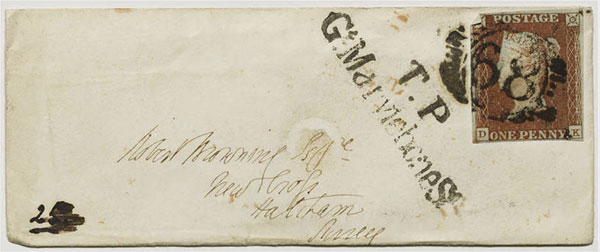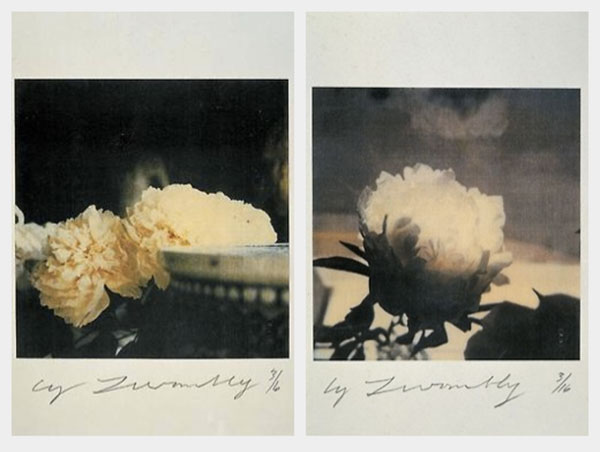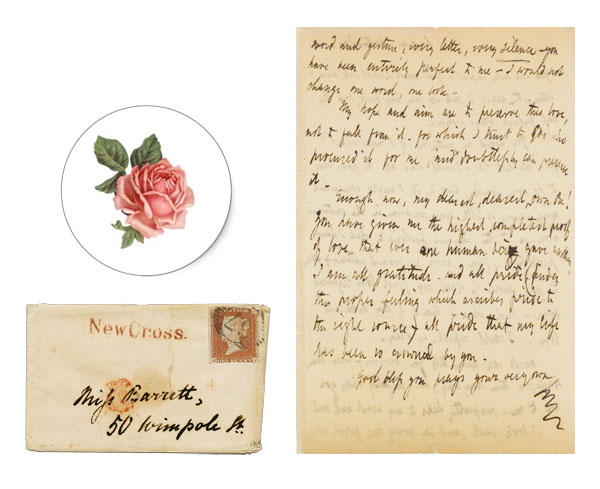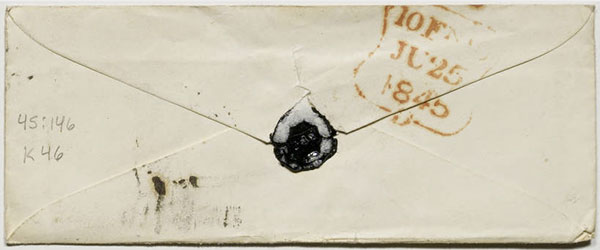Poetic love letters, a courtship, and loving one another until their dying day are but a rarity in today’s age, so a romance that combines all three must certainly be a great love story; although not the knight in shining armour of a young girl’s imagination, Robert Browning was Elizabeth Barrett’s hero, metaphorically sweeping her off her feet, loving and holding her until her dying breath.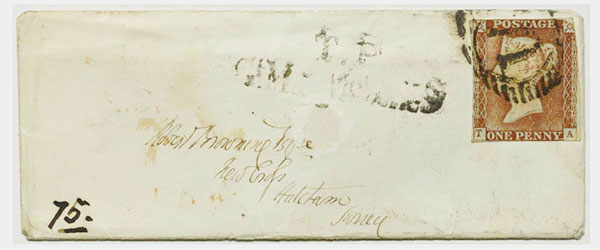
Elizabeth Barrett, born on March 6 1806, in County Durham, England, was an extraordinary child with a thirst for knowledge. Infatuated by Greek, English and Roman literature, she began writing poetry at the age of six and never stopped.
At fifteen, Elizabeth suffered a disease of the nervous system, for which medical science of the time was unable to diagnose, although many believed to be tuberculosis. The disease caused Elizabeth to become frail and weak and suffer terribly in the colder months, causing here to be largely secluded to her room, where she would write and read constantly. Other than her family, she saw very few visitors.

As Elizabeth’s work began to be published, her success and fame grew, and by the time her 1844 volume, Poems, was published, she was one of the most popular writers in the country. A long time aficionado, Robert Browning, finally decided to write a ‘fan letter’ of sorts to Elizabeth, the first few lines of which read . . .
January 10th, 1845
New Cross, Hatcham, Surrey
I love your verses with all my heart, dear Miss Barrett, and this is no off-hand complimentary letter that I shall write, whatever else, no prompt matter-of-course recognition of your genius and there a graceful and natural end of the thing: since the day last week when I first read your poems, I quite laugh to remember how I have been turning again in my mind what I should be able to tell you of their effect upon me…
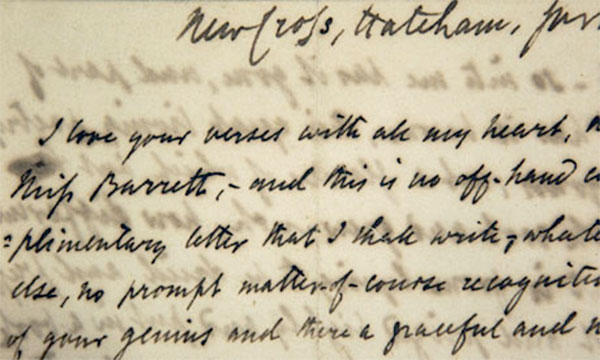
Above, Robert Browning’s first letter to Elizabeth Barrett
Quite bemused by the heartfelt letter, Elizabeth responded, just one day later, and after five months of exchanging further correspondence, Elizabeth arranged a meeting with Robert. There was an instant spark. Robert too, was an enthusiast of poetry and literature, and after discussing every topic from Pope’s Homeric translations to visionary romantic poets such as Shelley, a relationship began.
Throughout their 20-month courtship, some 574 love letters were exchanged. The love that grew through their correspondence seemed to be exactly what Elizabeth had been missing, as, after twelve long months, many of her ailments began to improve.

The letters sent discussed varying topics, but ultimately were intensely private — Elizabeth resorted to keeping her letters from Robert in a collapsible leather case, to reread them whenever she pleased, but on the rare occasion she left her room, she knew they would be safe. Robert too felt the need to keep his precious letters from Elizabeth in a secure location, opting for a beautifully ornate Marquetry box.
1 – Elizabeth Barrett Browning by Field Talfourd chalk, 1859 /// 2 – Robert Browning’s first letter to Elizabeth Barrett, January 10, 1845 /// 3 – the beautiful Marquetry box that Robert Browning used to keep his letters from Elizabeth Barrett /// 4 – Elizabeth Barrett’s reply /// 5 – the collapsible case Elizabeth Barrett used to keep her letters from Robert Browning /// 6 – pansy sent by Elizabeth Barrett to Robert Browning in a letter, August 10, 1846
Elizabeth’s father was intensely strict and did not approve of her relationship with Robert, whom he believed was with his daughter only for her wealth and celebrity. Seeing no other solution, Elizabeth and Robert eloped on September 12, 1846, at Marylebone Church and honeymooned in Paris.
One week later, they escaped to Florence, Italy to their new home, Casa Guidi [a few photographs here]. When leaving her London home, Elizabeth almost forgot her beloved letters from Robert, and, at the last minute, returned to collect the collapsible box so full of their love and history.
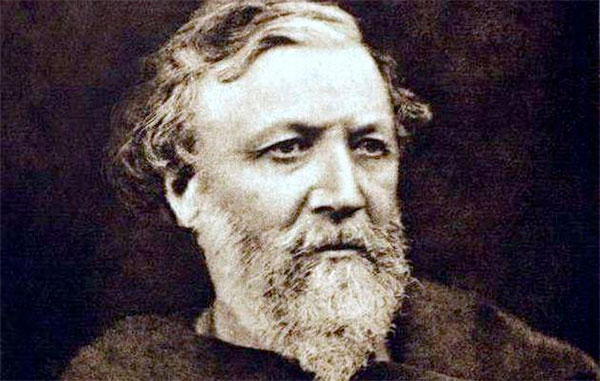
Above, Robert Browning
Upon hearing the news, Elizabeth’s father was furious and promptly disowned and disinherited her. Despite the situation, Elizabeth could not be happier or more in love with her new husband.

“I admire such qualities as he has—-fortitude, integrity. I loved him for his courage in adverse circumstances which were yet felt by him more literally than I could feel them. Always he has had the greatest power over my heart . . . “ —Elizabeth Barrett Browning
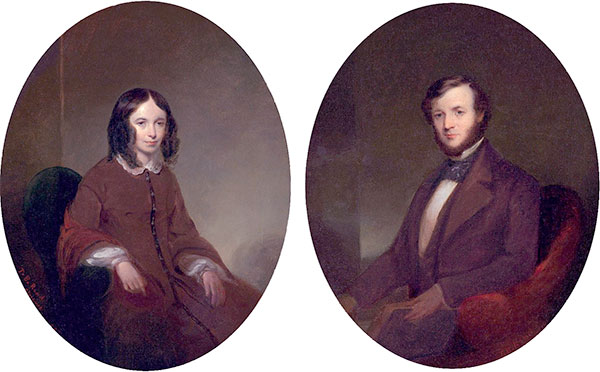
In the first years of their relationship, both Elizabeth and Robert wrote their most impassioned and expressive work. Leading up to their marriage, Elizabeth began writing a collection of sonnets dedicated to her future husband, and finally, in 1850, she showed them to Robert who, with her permission, published them as Sonnets from the Portuguese.
“I dared not reserve to myself the finest sonnets written in any language since Shakespeare’s.
—Robert Browning
Sonnet 43
How do I love thee? Let me count the ways.
I love thee to the depth and breadth and height
My soul can reach, when feeling out of sight
For the ends of Being and ideal Grace.
I love thee to the level of everyday’s
Most quiet need, by sun and candlelight.
I love thee freely, as men strive for Right;
I love thee purely, as they turn from Praise.
I love thee with the passion put to use
In my old griefs, and with my childhood’s faith.
I love thee with a love I seemed to lose
With my lost saints,—I love thee with the breath,
Smiles, tears, of all my life!—and, if God choose,
I shall but love thee better after death.
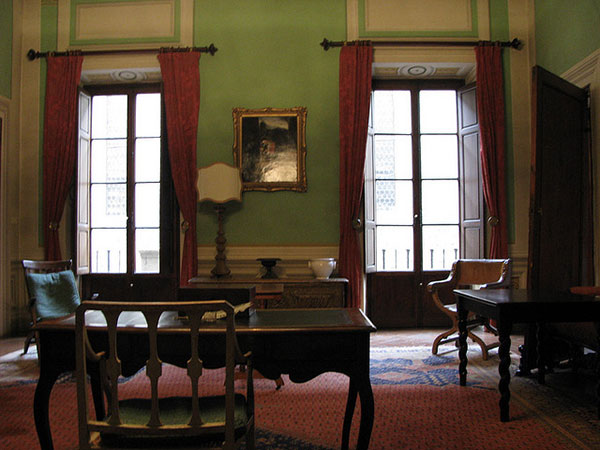
Above, the library at Casa Guidi, Florence, as it is today
The warmer climate and love and affection of her husband did wonders for Elizabeth’s health, and she gave birth to a son. Living an idyllic, creative life, the couple’s artistic circle of friends grew and their fame expanded to international status.
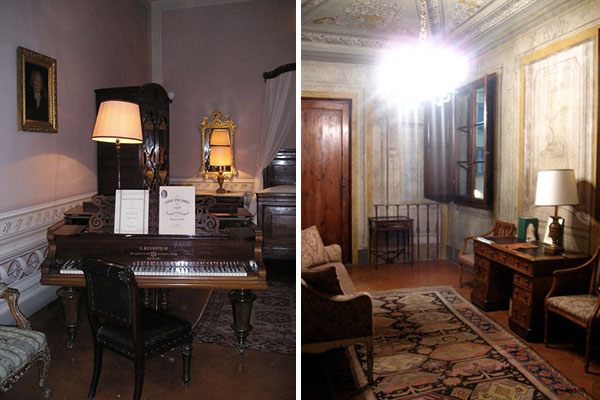
Above, the piano in the bedroom & Robert Browning’s studio at Casa Guidi, Florence
Although Elizabeth’s health improved, she never fully recovered, and at times she relapsed, and would be bed-ridden for days at a time. After 15 years in Florence, Elizabeth became particularly ill and was moved from her home to the fresh air of Siena, in Tuscany, Italy. She stayed in the Villa Alberti where she had much time to rest and recuperate. After 12 months, she felt well enough to return to the bustling Florence, but upon her return received news that her sister Henrietta had died. The news was enough to immediately undo all the good of her stay in Siena, and Elizabeth’s health declined as she became depressed, weak and enervated.

Robert was as attentive as ever, catering to Elizabeth’s every need and reading to her for hours at a time. On June 29th, 1861, Elizabeth died in Robert’s arms.
Robert later described that she died “smilingly, happily, and with a face like a girl’s…” Her last word was, “Beautiful“.

Above, the bedroom at Casa Guidi, Florence
Compassionate, gentle, benevolent — this is a tender and great love story of a hero rescuing his fair maiden. Robert saved Elizabeth from a bed-ridden life and showed her the world, loved her passionately, and inspired some of the world’s most romantic literature.
A benign love until its dying day, and stirring up the most beautiful words, rousing burning passions and healing a multitude of ailments — this love will never be forgotten, as it is written into their poetry, to live on forever.
“What’s earth with all its art, verse, music, worth compared with love, found, gained and kept?”
—Robert Browning


